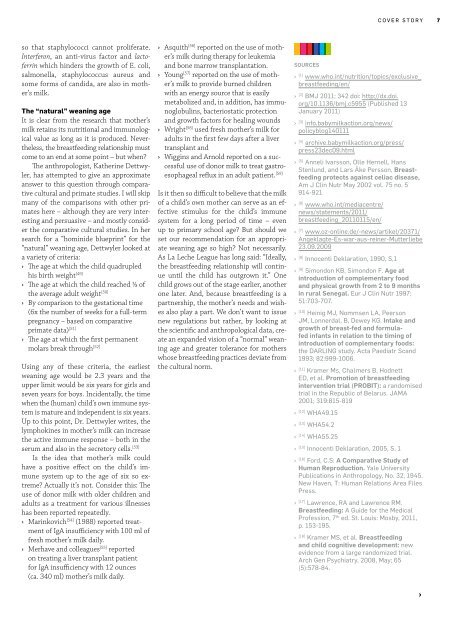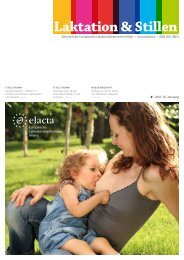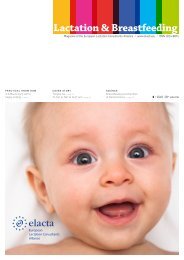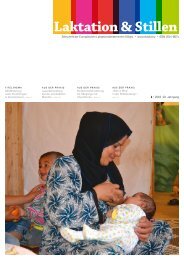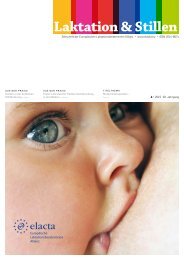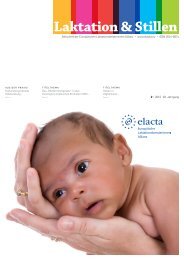Laktation_und_Stillen_2016-3 EN Web p1-10
You also want an ePaper? Increase the reach of your titles
YUMPU automatically turns print PDFs into web optimized ePapers that Google loves.
COVER STORY<br />
7<br />
so that staphylococci cannot proliferate.<br />
Interferon, an anti-virus factor and lactoferrin<br />
which hinders the growth of E. coli,<br />
salmonella, staphylococcus aureus and<br />
some forms of candida, are also in mother’s<br />
milk.<br />
The “natural” weaning age<br />
It is clear from the research that mother’s<br />
milk retains its nutritional and immunological<br />
value as long as it is produced. Nevertheless,<br />
the breastfeeding relationship must<br />
come to an end at some point – but when?<br />
The anthropologist, Katherine Dettwyler,<br />
has attempted to give an approximate<br />
answer to this question through comparative<br />
cultural and primate studies. I will skip<br />
many of the comparisons with other primates<br />
here – although they are very interesting<br />
and persuasive – and mostly consider<br />
the comparative cultural studies. In her<br />
search for a “hominide blueprint” for the<br />
“natural” weaning age, Dettwyler looked at<br />
a variety of criteria:<br />
› The age at which the child quadrupled<br />
his birth weight [49]<br />
› The age at which the child reached ⅓ of<br />
the average adult weight [50]<br />
› By comparison to the gestational time<br />
(6x the number of weeks for a full-term<br />
pregnancy – based on comparative<br />
primate data) [51]<br />
› The age at which the first permanent<br />
molars break through [52]<br />
Using any of these criteria, the earliest<br />
weaning age would be 2.3 years and the<br />
upper limit would be six years for girls and<br />
seven years for boys. Incidentally, the time<br />
when the (human) child’s own immune system<br />
is mature and independent is six years.<br />
Up to this point, Dr. Dettwyler writes, the<br />
lymphokines in mother’s milk can increase<br />
the active immune response – both in the<br />
serum and also in the secretory cells. [53]<br />
Is the idea that mother’s milk could<br />
have a positive effect on the child’s immune<br />
system up to the age of six so extreme?<br />
Actually it’s not. Consider this: The<br />
use of donor milk with older children and<br />
adults as a treatment for various illnesses<br />
has been reported repeatedly.<br />
› Marinkovich [54] (1988) reported treatment<br />
of IgA insufficiency with <strong>10</strong>0 ml of<br />
fresh mother’s milk daily.<br />
› Merhave and colleagues [55] reported<br />
on treating a liver transplant patient<br />
for IgA insufficiency with 12 ounces<br />
(ca. 340 ml) mother’s milk daily.<br />
› Asquith [56] reported on the use of mother’s<br />
milk during therapy for leukemia<br />
and bone marrow transplantation.<br />
› Young [57] reported on the use of mother’s<br />
milk to provide burned children<br />
with an energy source that is easily<br />
metabolized and, in addition, has immunoglobulins,<br />
bacteriostatic protection<br />
and growth factors for healing wo<strong>und</strong>s<br />
› Wright [58] used fresh mother’s milk for<br />
adults in the first few days after a liver<br />
transplant and<br />
› Wiggins and Arnold reported on a successful<br />
use of donor milk to treat gastroesophageal<br />
reflux in an adult patient. [59]<br />
Is it then so difficult to believe that the milk<br />
of a child’s own mother can serve as an effective<br />
stimulus for the child’s immune<br />
system for a long period of time – even<br />
up to primary school age? But should we<br />
set our recommendation for an appropriate<br />
weaning age so high? Not necessarily.<br />
As La Leche League has long said: “Ideally,<br />
the breastfeeding relationship will continue<br />
until the child has outgrown it.” One<br />
child grows out of the stage earlier, another<br />
one later. And, because breastfeeding is a<br />
partnership, the mother’s needs and wishes<br />
also play a part. We don’t want to issue<br />
new regulations but rather, by looking at<br />
the scientific and anthropological data, create<br />
an expanded vision of a “normal” weaning<br />
age and greater tolerance for mothers<br />
whose breastfeeding practices deviate from<br />
the cultural norm.<br />
SOURCES<br />
› [1] www.who.int/nutrition/topics/exclusive_<br />
breastfeeding/en/<br />
› [2] BMJ 2011; 342 doi: http://dx.doi.<br />
org/<strong>10</strong>.1136/bmj.c5955 (Published 13<br />
January 2011)<br />
› [3] info.babymilkaction.org/news/<br />
policyblog140111<br />
› [4] archive.babymilkaction.org/press/<br />
press23dec09.html<br />
› [5] Anneli Ivarsson, Olle Hernell, Hans<br />
Stenl<strong>und</strong>, and Lars Åke Persson, Breastfeeding<br />
protects against celiac disease,<br />
Am J Clin Nutr May 2002 vol. 75 no. 5<br />
914-921<br />
› [6] www.who.int/mediacentre/<br />
news/statements/2011/<br />
breastfeeding_201<strong>10</strong>115/en/<br />
› [7] www.oz-online.de/-news/artikel/20371/<br />
Angeklagte-Es-war-aus-reiner-Mutterliebe<br />
23.09.2009<br />
› [8] Innocenti Deklaration, 1990, S,1<br />
› [9] Simondon KB, Simondon F. Age at<br />
introduction of complementary food<br />
and physical growth from 2 to 9 months<br />
in rural Senegal. Eur J Clin Nutr 1997;<br />
51:703-707.<br />
› [<strong>10</strong>] Heinig MJ, Nommsen LA, Peerson<br />
JM, Lonnerdal, B, Dewey KG. Intake and<br />
growth of breast-fed and formulafed<br />
infants in relation to the timing of<br />
introduction of complementary foods:<br />
the DARLING study. Acta Paediatr Scand<br />
1993; 82:999-<strong>10</strong>06.<br />
› [11] Kramer Ms, Chalmers B, Hodnett<br />
ED, et al. Promotion of breastfeeding<br />
intervention trial (PROBIT): a randomised<br />
trial in the Republic of Belarus. JAMA<br />
2001; 319:815-819<br />
› [12] WHA49.15<br />
› [13] WHA54.2<br />
› [14] WHA55.25<br />
› [15] Innocenti Deklaration, 2005, S. 1<br />
› [16] Ford, C.S: A Comparative Study of<br />
Human Reproduction. Yale University<br />
Publications in Anthropology, No. 32, 1945.<br />
New Haven, T: Human Relations Area Files<br />
Press.<br />
› [17] Lawrence, RA and Lawrence RM.<br />
Breastfeeding: A Guide for the Medical<br />
Profession, 7 th ed. St. Louis: Mosby, 2011,<br />
p. 153-195.<br />
› [18] Kramer MS, et al. Breastfeeding<br />
and child cognitive development: new<br />
evidence from a large randomized trial.<br />
Arch Gen Psychiatry, 2008, May; 65<br />
(5):578-84.<br />
›


